|
Training Your Goose

Every pet needs to be trained. Your goose is not going to be a pleasant pet if you do not take the time to teach it what it can and what it can not do. It will become a better pet if you spend the time to teach it manners and a few tricks. You can not expect an animal/bird to know the rules of your home without training.
Have you ever seen a Parrot Trick Show? Do you think Hook Bills (parrot and parrot like breeds of birds) are smart? Guess what!? Geese are too.
There are many ways a goose can be trained. The best way is for the trainer/owner to be very consistent with the way they train, to be consistent with the training, to make training, or using words correctly to their birds consistent. Take the time it takes for your own goose. Do not base your training or the training of your goose by the training of someone else working with their goose. Every trainer/owner is different and every goose is different. What might take one goose two sessions to learn might take another ten sessions or more to learn.
Once your goose has learned to learn, the easier is it to train the next behaviors and or tricks you are teaching the goose.
(much more to come)
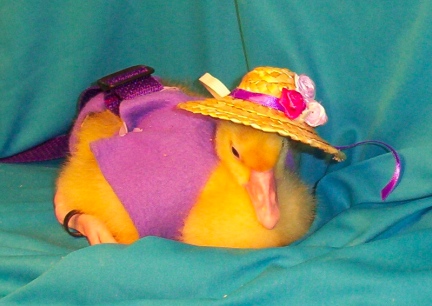
It is, of course, easier to train up a gosling with consistent training than to bring home a full grown goose and try to teach it everything quickly so that it and your home as well as yourself and your family & friends are safe. Goslings can be distracted from bad behavior easily than an adult, but that does not mean that adults would not work out as a good pet for a person that has owned geese before. I would never say that it could not be possible to teach an adult goose to wear a diaper holder, but I will tell you that if you do not have the heart for a mess, goose poop on you and your clothing, then don't even start the procedure. An adult goose is not going to let you change it's diaper without a fight if it did not grow up wearing them.
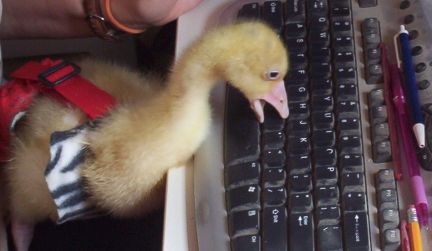
Geese can learn tricks. There are all sorts of tricks you can teach them. Some are easy to teach some are hard to teach and then, some geese are harder to teach then other geese. (more to come)
Most of us that own geese talk about them all the time. We love our geese and don't understand why everyone does not own them. House Geese is new to a lot of people and we that own them want to brag at any given opportunity. If your goose is not trained and is unruly or in fact a rude pet (biting, chasing, pooping on the floor) save your breath, folks are not going to hear you. However, if you have a well trained pet, one that people can enjoy, even if they can not pet it, then they will listen to you all day about it. Either way, they will tell others about your pet.....what you want them to say, how you want geese as pets to be seen by the public, is up to you and the way you have trained your pet goose.
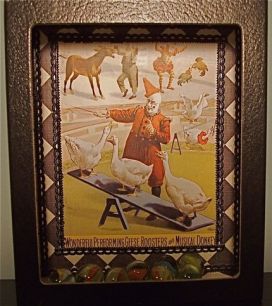
No matter how well trained your goose is be realistic. Don't think for one minute it would be safe to take your goose to a Dog Park. Your goose may be well trained, but loose dogs will always pose a threat to it. A dog can grab and kill your goose faster then you can say "NO! DOG! NO!"
The other side of that coin is do not take your goose to an area with unattended children. Not only will many geese bit the kids, but your goose might be sat on by some brat and then the parents blame you. It is the type of world we live in. Shame, but true. If you do come across unattended children while out with your goose, pick your goose up and keep the children away from it until or unless the children's parents are there to approve them touching the goose.
Just Who Is Training Who? Every time you interact with your goose, it is learning something. Every time. Now? The question is, What is your goose learning? Is it learning to behave to have manners or is it learning that it can manipulate you? Children and animals are smarter then most people give them credit for. If you want your goose to be a fun pet, one that you and your family and friends can really love, take the time to train, teach, work with, your goose each time. That means staying consistent with what you tell the goose. "No" means no every time you say it. When you laugh at bad behavior, your goose/any animal/children see that as you being pleased with what they are doing.
On that. Everyone in the family should also be using the same words for the same behavior you are shaping the goose to learn. Can children teach animals. Yes. If the child is well behaved themselves, love the animal and understand that punishment training will not work and should not be used with a goose, a child can train an animal. I was about 6 years old when I trained the first animal I ever trained (there have been many between then and now) and it was a Bantum Chicken.
The contents of this page for Training Your Goose is still under construction. Please check back.
SPEND TIME WITH YOUR HOUSEGOOSE
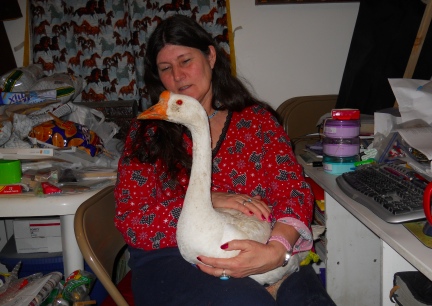
Everyone that brings home a new animal spends time with it....what your need to spend is quality time with it. Most of us will bring home a gosling that we will raise to be a housegoose, and that can be either good or bad. Raising your own animal prevents having to retraining it. Retraining is harder then training an animal (or person) from the beginning. But, then, you need to know how to train or the animal is going to grow up without training and be unruly. When you raise your own animal there are usually not many surprises. When you bring home an adult, count on many surprises of things it has learned, or not learned, that will pop up in everyday life....and some of these behaviors can be very dangerous.
When you are raising a housegoose (or housedog or housecat or....) you need to spend time with it each and every day of it's life. You do not want to hold it too much so that it becomes spoiled and "needy", but you do want to hold it and pet it and let it fall asleep on your lap so that it knows that it is safe with you and it has someone that loves it.
MORE coming soon
DON'T SPOIL THAT GOSLING!
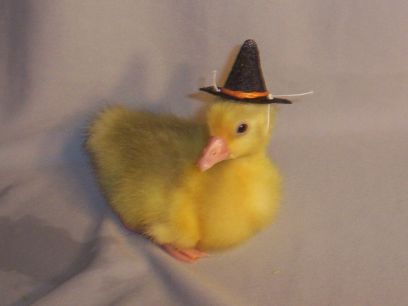
Those little goslings are so cute and soft and loving and they love to be held, will follow you to the ends of the earth, will eat right from your hand and it tickles.....but spoil that baby and you will have an obnoxious large flapping, biting, demanding bird on your hands. You want your gosling to grow into a well mannered, likable pet, not a witch like animal that no one wants to be around.

Spending time with, bonding and caring for your gosling is all very important. You need to hold them and love them and teach them. But catch that last word, teach or train them. Just like with a child or puppy, don't let a baby gosling get away with bad behavior just because it is cute while they are little. You are not doing yourself or the bird justice if you teach them this way. If you would not allow your full grown large goose to do something in your home, do not let the gosling do it young. Teach your gosling good behavior and you will have a bird that not only you will love to be around, but others will admire.
I have seen people for many years that will buy a young animal, spoil it, not train it, then when the animal hits it's not so little and as cute stage, they get rid of it because it just will not behave. Sad. And worse. No one else wants it either. When it comes to a spoiled housegoose, this is a tragic thing. Not only will the spoiled ill trained goose not find an indoor home that it is used to, it will not know how to act around other geese and will not fit in on a "farm". You can not just turn a goose loose in a park with a pond, so what happens to this poor spoiled bird????? Don't let this happen to your beloved pet. Start training it as soon as it comes into your home. Teach it to behave, teach it manners, teach it to be loving with other animals and with people. Not only will you yourself like the animals better as an adult, if, God Forbid, your life would change or end, your goose would be able to get a good home with people that will love it.
TEACHING YOUR GOOSE MANNERS
So what are good manners for a housegoose? Geese are very large birds. It is not funny or cute if your goose chases family members or company that visits around your home. It is not funny or cute if your goose bites, and a goose bite hurts. It is not funny or cute if your goose is flapping it's wings and knocking stuff around your home. What is cute, what is fun, what is acceptable, is a well mannered goose that is a pleasure for everyone and or anyone to be around in your home or out on the streets where it visits.
You can not spank a goose and think you are "teaching" or "training" it. Geese need to be told "NO!" and moved away from or distracted from their wrong behavior. If, for example your goose is chewing on your electrical cords, tell it "No." and distract it with a goose toy. Or if your goose is trying to get into your beverage glass, tell the goose "No." and take it to it's own water bowl and add a bit of water so that it sees the water going into the bowl.
You need to be consistent in your training. Don't give up, hang in there even if you think there is no way this bird brain is going to learn. If you are consistent, if you bird can trust you, IT WILL LEARN! All of a sudden you will realize all the human words your goose knows and you will smile.
COMING WHEN CALLED BY NAME
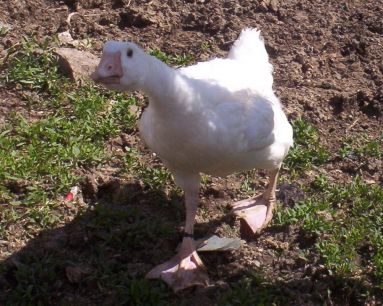
This is easy, oh so easy. When you first get your pet say it's name often. When you first call your pet to you, give it a treat and petting. Each and every time you call your pet make it a good experience for your pet. Call you pet's name when you feed it. Call your duck or goose's name when you lead it to water or put it into the bathtub with water. Each time you call, make it fun or pleasurable for the animal. Soon, and most times very soon, the animal will come running when they hear you call them by name.
Stop That Thrashing Around When a goose does not want to be held, or does not want to be in an area you have it in, it will probably "Thrash Around". This is when it makes much like a swimming motion, or stomping motion, many times flapping it's wings. If you are holding the goose in your hands/arms, stop and do not move, hold right where you are and say "Stop!". Repeat the word if you need to and just hold on to the goose and don't move. The goose, much like a puppy being held on it's back while training a dog, will stop moving. When the goose stops moving, you move, set the goose down, continue diapering, or whatever it was that you were doing with the goose when the thrashing began. IF the goose starts thrashing again, say "STOP!" in a firm voice and repeat the non movement. Geese are smart, they catch on to this quickly and don't like to be held in the one place. So they will learn to stop what they are doing when told.
Yes, Geese Can Learn to "Stay" 
Of course you might not ever be able to get a goose to "sit stay" for more then 30 seconds, but a 30 second "stay" usually gives you the time you need to move the goose from danger or get that cute photo you were hoping for. Consistence on your part is the biggest factor when training. One goose might learn this in five training sessions, for another it might take 65 sessions to learn this command. However, this command could save your goose's life or keep it from harm.
Teaching Your Goose That "No" means "No" If you are going to keep a goose in your home, the goose must learn that the word "No" means "No", not once in a while, not only when you yell it, but each and every time you say the human word "No" it means "No". This means that whatever you are doing, where ever you are, if you say "No" to the goose, you are ready to back that "No" up. There is nothing worse then an spoiled animal or human child that does not have to behave and when told "No" they push the limits just for attention. Many times a parent thinks it is cute to have a child or animal that does this. It may be cute to them, but surely not to others around them and dangerous behavior for the child or animal.
"No" can be used for a number of things that I do not need to go into. However, it should not be the only word you use with your goose. "No" might mean, not to touch something. But the truth is, "No" should be followed with "Leave It" so that the command is clear to the bird. A "No" is good for the bird to learn so that it stops WHATEVER it is doing and waits to hear what you want. An example would be that if you walked into the room and your goose was chewing on a live wire. A quick "NO!" should stop the bird and give you time to move the wire and the goose. However, if you also teach your goose to "Leave It" the bird should walk away from the wire on it's own.
I guess my biggest point here is that a person should not over use or abuse the word "no" to the point where the animal begins to believe that it's name is "No".
Some times when animals, of any sort, become aggressive, and especially at those teenage years, they need to be dealt with. If you do not deal with it then than the animal will continue and can become worse, thinking they are the ones in charge. This is what Deron and I have done with success, but others might find it harsh. We have trained animals a long time and have learned you have to treat them, now and again, as they do one another. Our gander Blue was starting to bite us. What we did was to take hold of his neck when he came to bite. You quickly grab the goose under the head, but not tight. Give a stern (to the loud side) "NO!", hiss at your goose. Hold on. Just hold on til they surrender. Do not squeeze. Do not lift them off their feet. Do not pick them up by the neck. But hold on. Stare right into the goose's eye. What you are doing is two fold. You are stopping the first aggressive move on your goose's end and you are holding the goose so that it can not move toward or away from you. Showing dominance. This is the same thing as rolling an aggressive puppy over on it's back and holding it there until it relaxes and looks away from you. Or like a slap on the side of a colt that is lining up to kick at you. Now. You need to know. Your goose may come back like four or more times in a row just to test you again. But soon after, and we know for a fact, when you say "NO!" and look right at your goose, it will turn away....... Blue does still once in a while do this and when we give that stern "NO!" acts like "Oh did you think I was going to bite you? Oh No. I thought there was a bug on your leg." As he walks away proudly.
When you roll over a puppy or slap the side of a colt you are mimicking what they mothers would do to them as disipline. They understand it as such. With geese their is no good way to bite them (as they do one another)....but we mimic the same behavior patterns with the dominance of holding them and that hisssssssss at them as you look them right in the eye.
TEACHING YOUR GOOSE TO WALK ON A LEASH 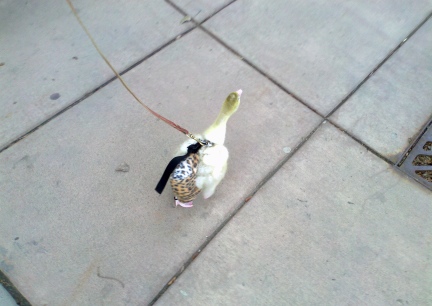
If your gosling/goose is bonded to you it will follow you everywhere. If you have taught your goose to come when called you can use this to coax it along as your walk. Starting your goose as a gosling to follow you is the easiest way to teach your goose to walk on a leash. These gosling photos are of Dinah Soar.
The photos of the adult goose in this Leash section (on leash) are of Nichole Duman's (www.DumansArk.com ) handsome pet goose, Quigley. He was raised from a gosling as a pet in Diaper Holders and was walked on a leash as a youngster. Quigley enjoys outings to the Flea Market quite often as well as Pet Stores and he likes the idea that he can walk right along like all the other people. The Diaper Holder with Leash Ring is one made by www.workingwings.com
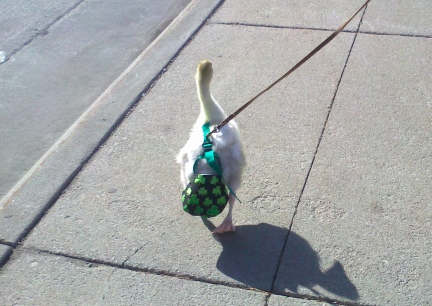
The most important part of teaching your goose or other animals to walk on a leash is finding a harness and leash that are appropriate and safe for your pet. You CAN NOT just snap a dog leash on the back of your goose's diaper holder and go. You must try out all harnesses for safety when used as a leash harness at home, in a very safe, fenced or indoors first. Make sure the harness will not just come off the goose sideways if it gets scared or chased. Make sure the snap on your goose's harness is small and light, not big, heavy and bulky for their backs.
Do not use a collar around your goose's neck.....for many reasons. First and foremost is that if a dog, child or other predator goes to chase your goose and it runs with you holding tight to the leash it's neck is connected to, you might just choke your goose or break it's neck yourself.

After you have found a good harness and a light weight leash for your goose that follows you everywhere, you are safe to go many places with your goose with you on leash.
Why use a leash on a goose that stays right with you and follows you everywhere? Because you are going off your own property and will need to be not only responsible, as dog owners should be, but also will be able to hang onto your goose should it be frightened or threatened.
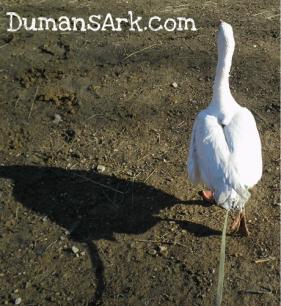
If your goose does not follow you around. It will be hard for you to teach your goose to walk nicely with you on a leash. Start by training or enticing your pet goose to follow you when called by name (see above how to train your goose to come when called). It is not safe to take out a goose on a leash that is not willing to follow you.
KEEP IN MIND THAT IF THE PAVEMENT IS HOT FOR YOUR BARE FEET, IT IS ALSO HOT FOR YOUR PET'S FEET TOO. BE PREPARED TO CARRY YOUR PET IF THE SUMMER DAYS GET HOT AND YOU ARE WALKING ON PAVEMENT.
Tricks To Teach Your Housegoose
I had Banty Chickens as a kid. A Buff colored Banty Chicken was the first animal I ever trained to do tricks. Through the years I have taught many many animals and am still training animal. One of my favorite things to do is to teach animals to do tricks. I usually teach an animal to do tricks before teaching much else. Teaching an animal to do tricks teaches an animal to learn. Animal like to be with their people (if raised right that is) and they like to please their people. When animals learn little easy tasks and tricks they will preform them for the praise and the treats and the attention it will bring....yes, even birds.

Most birds and animals can learn much if the trainer can communicate to them correctly.
Start slow and break the trick apart into very small steps. If someone came to you and spoke a foreign tongue and was trying to teach you something what would it take for you to understand? Work your bird with that same perspective. Use simple cue word, talk slowly, smile, and encourage your bird with a gentle hand. I have honestly seen humans talk louder and slower to an animal, thinking I guess, that the animal would understand better if the words were just a bit louder. That will not work.
Birds and animals can and do learn words we teach them. Words, not paragraphs. Keep commands as one word and use the same word consistently. Something I have noticed with the average person when they train a dog....when they tell the dog "down" it might mean, "get off me" and another time it might mean to "lay down" and another time it might mean to "get off the couch". That same person thinks the dog is stupid if it does not understand what the person means each time the same thing is said. If you use the same word "down" for all three commands here's what might happen....you come in and the dog is sitting on the couch. You say "down" and the dog lays down on the couch and you get mad at the dog...who is in the wrong here? Keep the same word for the same action you want and use it each and every time. Give each action it's own simple cue word. This applies to dogs and cats and birds and young children. Chose your cues and be consistent.
TRICK IDEAS AND HOW YOU MIGHT TRAIN THEM TO YOUR BIRD(S) Below are ideas and instructions on how you might teach your bird to do tricks.
We are still working on our bird tricks page, more Bird Trick ideas will be added as we go. There will be pictures added soon.
OUR WEBSITES ARE COPYRIGHTED, ALL WRITTEN AND PHOTOS AND EVERYTHING WITHIN. Always remember when training any animals, that each trainer and animal is different. Each person trains a little different even when training the same thing in the same way as another trainer. Each animal you train is an individual. You may be trying to train two birds at the same time, which by the way is a very good idea, not the exact time, they each need one on one training, but training two birds so that they can watch each other learn.
I can only tell you what has worked for my husband Deron and I training our own animals. I CAN NOT be held responsible for the type of training you do with birds or other animals that may or may not be ready for this type of training.
When training be sure to... Be patient. Be fair. Be nice. Stop before the bird gets tired or before you get frustrated. Be sure you are showing the bird what you want in small steps so that it can understand what you want it to do. Do more with your birds then just train, in other words, hold your birds, scratch/pet your birds, spend time with your birds. Use small treats while training. Most of all, Have Fun and Be Safe.
JUMP THROUGH A HOOP
As a young child, early grade school, I taught my pet chicken to jump through a hoop and over a stick I held out. It is not rocket science, but you do need to know how to make the bird understand what you are asking it to do. Many birds, most in fact, will take a treat from your hand. That will help in training.
You will need a hoop that is the right size for your bird. If you are working with a parakeet you will need a smaller hoop than if you are working with a goose. Chickens can jump through a hoop that is further off the floor then a goose, and parrots can have a higher hoop then a chicken. But keep the hoop low to the ground for your birds.
This is an easy trick to teach and one of those "big deal" tricks for onlookers. At first do not decorate the hoop. Place the hoop in your left hand (bird on your left side) hold a treat in your right hand. The hoop should be sitting on the ground, floor or table. Show the bird your treat and tell the bird to "Jump Thru the Hoop". Move your right hand so that the bird has to follow the treat coming all the way thru the hoop before reaching the treat. NOW: You may have to move the hoop, keeping the hoop directly in front of the bird, if the bird tries to go around the hoop, distract it with the treat and encourage the bird to come forward thru the hoop. The bird will probably only walk rather then to jump thru hoop the first few times. Practice makes perfect. When the bird is all the way thru the hoop, give the treat and make a huge fuss with verbal praise!!
Keep working with the bird with the hoop almost touching the ground, when the bird is jumping thru the hoop, raise it a bit, just a bit. Soon your bird will be jumping the hoop.
To Add Glamor to This Trick: After your bird is Jumping Thru the Hoop well, you can add streamers with ribbon.
Or cover the Hoop for that TA'DA' ending to a trick show.
To teach your bird to come through a covered hoop.... first teach it to come through the hoop for a treat. Then have plenty of newspaper and tape on hand. Add just a strip of newspaper to each side of the hoop. Tape paper to paper, not to your hoop. After your bird comes through the hoop with the newspaper strips on each side add a strip of newspaper to the top and bottom of the hoop, again, tape paper to paper, not to your hoop. After your bird comes through that add a little more paper. Make a big fuss each time the bird comes through the covered hoop. Keep closing the hoop off with more and more newspaper, however leave a hole in the middle about 3" so the bird can target that space. Now when you do this as a show off trick, you tissue or wrapping paper or paper you have written on that says, THE END or TA'DA or the like.
Later, after much hoop work, you can teach a parrot to fly through a hoop. Have fun and keep it safe.
FETCHING A LIGHT WEIGHT ITEM
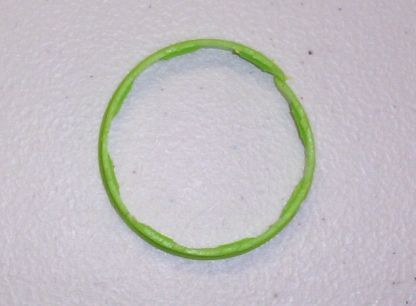
Milk jug lid rings make a great first fetching toys of birds. It is light weight, has color and being round, easy for them to pick up and carry.
more to come on how to teach your bird to fetch
DANCING IN A CIRCLE
This is soooo easy to teach any animal that will take a treat from your hand. If you bird does not take a treat from your hand, teach it to enjoy that pleasure first. Use one piece of something, not a handful. Most, if not all birds will ravish sunflower seeds.
Once the bird takes the treat from your hand hold your hand above the birds head and cue the bird by saying "Dance In A Circle" or "Dance" or "Turn Around" or the like. Move your hand in a circle around the birds head so that the bird follows you hand moving in a full circle, give verbal praise and let the bird have it's treat. After you do this a few times you will probably only have to cue the bird and move your hand into position and the bird will "Dance".
RINGING A BELL

Pavlov's Dog. If you ring a bell and then give your animal a treat, the animal will come when it hears the bell ring. Take that a step further. Have your animal ring the bell for the treat.
You will need a small bell. The bell should have some sort of handle so that you can hold it for the bird. Later you might want to hang a bell for the bird and teach the bird to go to the bell and ring it on the command "ring the bell".
First you have to get the bird used to the sound of the bell. Then you need to get the bird used to the bell up close/louder sounding. To do this, ring the bell softly at first. Ring the bell when you feed your bird or just before giving a treat. And or ring the bell, or have someone else ring the bell while you remain calm (in the birds eye) and petting the bird. As the bird gets more used to the bell, move the bell closer to the bird and ring it softly. Beware. Some birds will be afraid of the bell ringing.
Once you bird is unafraid of the bell. Hold the bell for at face height for the bird and give the cue, like this one "ring the bell". Most birds will touch the bell or even peck the bell, if your bird does this, even just a bit, treat and praise the bird. Repeat.
It will not be long before your bird is pecking the bell. If it rings at all, give the bird a treat, praise the bird verbally. As the bird learns to peck the bell, wait for the bell to ring a bit louder before giving your bell treats and verbal praise.
Remember that you are training the bird. Do not let the bird train you. Only give the bird a treat when you give the bird the cue words, not when the bird decides to ring the bell.
TELL ME A SECRET
This is a fun little easy to teach trick. First of all your bird should be tame and calm. Now, put just hold a sunflower seed on the side of your face by your ear, show the bird and let the bird have the treat when it reaches for it. Do this at your own digression, your bird might bite or become pushy and want to check your face too often. A well trained bird that is taught this trick on command will be a real crowd pleaser. When you hold the treat by your face near your ear, give the cue or command to "Tell Me A secret".
PLAYING PIANO
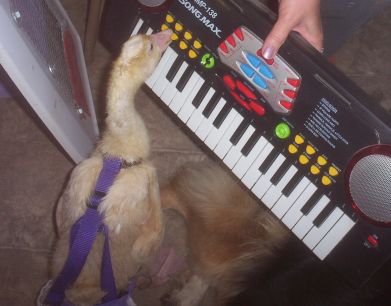
Just about any little piano or keyboard will work for your bird. Getting the size that looks right for that bird will be the harder part. These are sold all day long at garage sales, thrift stores and the like. You might even find one in your own home.
The first thing you have to do, and this is usually easy, teach the bird that the noise is good....do this by holding the bird and giving it treats while you softly hit a key or tow on the keyboard. The best way to do this is hit a key, give a treat.
Next what you will do is set the bird on the far side of the keyboard. Another words, set the keyboard down on the floor or table and set the bird on the other side of it. From here you can do this two ways. The best way will take a little longer to teach. That is to teach the bird to peck or step on the keyboard then take a treat from your hand. The other way is to set the treat on your keyboard and hope the bird peck the keys when they pick up the treats.
When the bird touches the keyboard, even if it does not make a sound give verbal praise right away, then make the sound with your own hand and give a treat. And like a person first learning, it takes practice, practice, practice to learn to play a piano.
BOWLING
This is a very advanced trick. Your bird will have to know how to do other, more simple, tricks.
There are several ways this can be taught to a bird. You can also use several different items for your bowling pins and balls.
Your bird, or any species, will need to get used to the noise of the pins falling. It needs to get used to the ball and the ball rolling. So you start your training with desensitization.
Once the bird is not afraid of the pins or the ball. Have your bird walk among the pins and around the ball. You know how there are different "bowling stances" among humans? Well in birds there is even more of a difference. Some birds will push the ball with their faces. Some will walk up and push the ball with their body's. Then others, they might just take a run at the pins leaving the ball behind. Now? If you could teach your bird to do each way. Or have three birds that each bowled a different way...you have a whole show right there!
GOOSE: You might want to use a beach ball for your goose to bowl over the pins you have either bought at a toy store that are 8" to 12" (all matching in size or course), or empty water bottles.
DUCK: You could use a child's light weight play ball or a light weight plastic ball with the pins you either buy from a toy store or use empty water bottles.
CHICKEN: For your Chicken you will need a light weight plastic ball about 4" - 6" in diameter. Most toy stores have such a thing and also look at garages sales. For pins. Look at kid's bowling pins in toy depts. I got several different sizes from our Dollar Store, with a ball. The one's I will be using for our chicken are approx 4" tall.
PIGEON: You will need a small light weight ball. Your bowling pins will need to be about 4" tall and very light weight.
[more on bowling to come]
WEAVE IN AND OUT OF YOUR WALKING LEGS
It is a fun and easy trick to teach that will go very well when you carry treats. Your bird needs to know it's name and come to it. If you have a big goose, you will need to have long legs.
Take a treat in your left hand and call the bird toward you as you show it the treat, now hold the treat between your legs as you take a large step and stop with your feet as far apart as needed for the bird to be able to walk under you.
Call the bird's name and give much verbal praise and encouragement as is needed to keep the bird moving forward and under your body.
As the bird comes through your legs, give it a treat, grab another treat, have several in your pocket or treat holder, and take a large, exaggerated step repeating the same only using the other hand to bring the bird through your legs in the other side.
Continue, but go as slow as it takes for the bird to catch on. As the bird catches on, have it come through one, two or three steps before giving it the treat. When the bird fully understands, take about 5 steps and end the game there giving the bird a treat for it's efforts.
TEACHING ANY PET TO OPEN A GIFT
You can teach your pet, any pet, Yes, even a bird, to open a gift in a few easy steps....
Start with a small box. A mouse will need a smaller box then a GP and a GP will need a smaller box then a dog. Use a box that does not have a lid about the same size as your pets food bowl.
Set a treat in the box next to their food dish when feeding. When they take the treat out of the box, say "gooooood" and remove the box. Repeat twice a day for a few days.
In a few days, after the animal has caught on to retrieving the treat from the box, wrap the box, but not the top, with colorful paper. Repeat the idea of leaving this with a treat in it for your pet....most will not even notice the box has changed, or if it did notice it did not care.
Now. Take a piece of newspaper, or tissue paper and wrap it around just the edges of the top of the box. Give a treat in this box, same as before, to the pet. Then next day make the opening a bit smaller, ie, rewrap the top of the box but extend the edges closer to the middle of the box. Give this to your pet as before. Then next day, make the middle smaller and so on. Finally, close the top with paper and watch the animal "open their gift.".
Teaching Your Live Goose To Wear Clothing 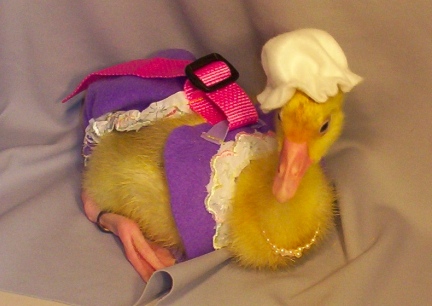 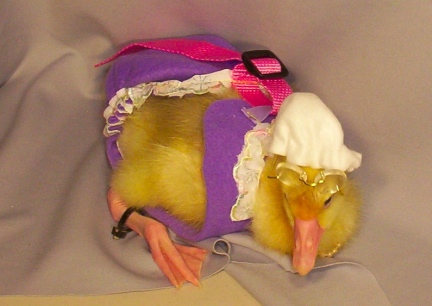
If you have a goose that you have diapered since it was a gosling, you should not have trouble putting an outfit on your live goose. You of course do not want to put anything too tight on your goose.
The gosling in the photo is Eden, our HouseGoose. She was so used to wearing diaper holders and hats, that I added the glasses and necklace. She never cared what kind of clothing or accessories I put on her because she always knew I would make a fuss over her when she had them on.
If you are planning to dress your goose as an adult, handle your gosling often and touch it all over, feet, neck, head, chest.... Put clothing and accessories on your gosling/goose for just a moment, distract the goose with affection, a toy or even food and or water. Praise the goose in a happy voice. Only leave the item on the goose for a short time. Then repeat. Go about this slow, don't add a hat and skirt and necklace and.... all at the same time. Teach the goose to wear a hat. Then add your outfit. A few days later add a necklace. Make it fun for the goose. NEVER, EVER, LAUGH IF THE GOOSE FLIPS THE ITEM OFF IT'S BODY OR ACTS UP/OUT ABOUT A NEW PIECE. IF YOU LAUGH, IF YOU MAKE GOOD TYPE OF FUSS OVER THE BIRD, IT WILL REPEAT THE BEHAVIOR FROM NOW ON. What you need to do if the bird flips the hat off it's head, is say "No." in a firm voice and put the hat back on the hat, and say "Good." right away.
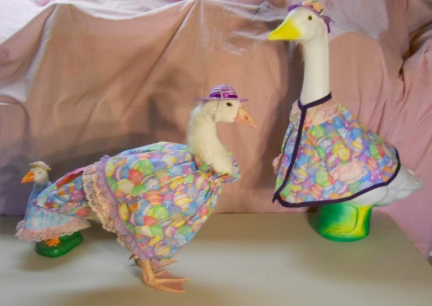
I am NOT A CLICKER FAN. But if a clicker works for you. Use it. The word good is your own unique voice. You can flex it, change the tone, your goose already knows your voice and how you use it. And your voice does not fill up the hands you might need for correction, as in moving the goose, or resetting the goose, or catching something as it falls. Further, you will always, immediately, have your voice at all times, right there ready to use. Many people have no idea how keenly our animals listen to use and read not only our body language, but also the tones and flexes of our voices. So when working with clothing on your goose, keep that happy tone and the word "gooooood" as your training tools.
Once your goose dresses up..... you must make sure that whatever you put on your goose it is safe for it to wear. If you have a necklace on the goose, you do not want it too long or the goose will try to eat it. If you are making a goose necklace with beads double the fishing line and fill the entire loop for that A) the goose can not break the necklace and swallow the beads, B) with beads all around the line will not hurt the gooses neck, C) with the shorter necklace length the goose can not get it's beak around the necklace to bite it or pull on it. Make sure, if you goose has an outfit on, make sure the goose can walk in it that is it is not tripping on the outfit or that it's toenails are not getting caught in the edge of the bottom. Also make sure that the goose can lay down and get up while wearing the outfit. The way your goose's body is shaped, this can be a problem. Other tips: Add proper sizes elastic to hats so that they stay on the goose's head if the goose tips it's head. Velco is your friend, use it so that the outfit can come off quick if it gets caught on a toenail or something. Diaper Holders that are dressy can be just as cute as an overdressed goose. And just like people, sometimes, less is more!
Most outfits are for photo sections and short time wear anyway. But keep in mind how it feels and wears (safe) to the goose. Again, and again I will say MAKE IT FUN FOR THE GOOSE TO WEAR THE OUTFITS.
THE "GO TO" TRICK
The "go to trick" is the trick your animal will go back to when it does not understand what you are trying to teach it at the moment. Your bird wants it's treat, so it will try to continue to please you. If it does not understand what you are trying to teach it at the moment, the new behavior, your animal will go back to a trick it does well and see if you will treat if for doing the "go to trick".
When your bird does this tell it, "good", with a quick and quiet voice, but do not give the animal a treat or a smile on your face, replace the animal to where it was and continue teaching the new behavior. When it "gets" the new behavior make a big deal in voice and face (big smile) and give the treat.
WHERE TO GET YOUR TRICK PROPS Finding Bird Trick Props is not as hard as you first may think. Look at Garage Sales, Thrift Shops and your own children's toy boxes. Some items you may want to pick up are... a hula hoop, a toy piano, hats, clothes, big sunglasses, bean bag chairs, a magic wand, a wagon for your bird to pull or ride in, large hard cover books, and the list just goes on and on. THINK while you see that stuff, can you use it for Bird Tricks? You will not have to pay much for the items. Another thought is photo props. If you like to take cute photos of your animals pick up seasonal items for next to nothing for photo props. An Eater Basket, a small artificial Christmas tree, a Happy Birthday sign, you get the idea, have fun!!
A WELL TRAINED HOUSEGOOSE A well trained well mannered housegoose is not only a pleasure and charm to be around, it is also such a good ambassador the geese everywhere.
Your goose could change the publics view on geese in general. So many, and more today then ever in history, people are not raised around animal. They have these ideas, bad and incorrect ideas, of what geese are. Dirty, mean and germ spreading birds that are to be avoided and even killed so that they do not mess up "the people's" park or pond.
FOR MORE INFORMATION ABOUT KEEPING A GOOSE, DUCK, CHICKEN IN YOUR HOME AS A PET, PLEASE VISIT
COMING SOON! MY SPOILED CHICKENS
-- The House Goose Team
Fri, 11 Mar 2011 15:36:40 -0500
| 



 In the high plains of South Dakota, USA
In the high plains of South Dakota, USA In the high plains of South Dakota, USA
In the high plains of South Dakota, USA